Women Empowerment and Promotion of Democracy in the Middle East
VerifiedAdded on 2022/11/25
|17
|4645
|308
Report
AI Summary
This report investigates the concept of women's empowerment in the Middle East, exploring its historical context and contemporary practices. It examines the challenges and advancements in gender equality within the region, particularly focusing on Morocco and Turkey as case studies. The report analyzes legislative reforms, educational opportunities, and societal perceptions impacting women's roles. Furthermore, it discusses how women's empowerment is linked to the promotion of democracy, emphasizing the importance of women's participation in political life and the impact on democratic quality. The research employs interpretivism, inductive approaches, and explanatory research to gather reliable information and provide in-depth analysis of the subject matter.

Running head: WOMEN EMPOWERMENT
Women Empowerment
7/12/2019
Women Empowerment
7/12/2019
Paraphrase This Document
Need a fresh take? Get an instant paraphrase of this document with our AI Paraphraser
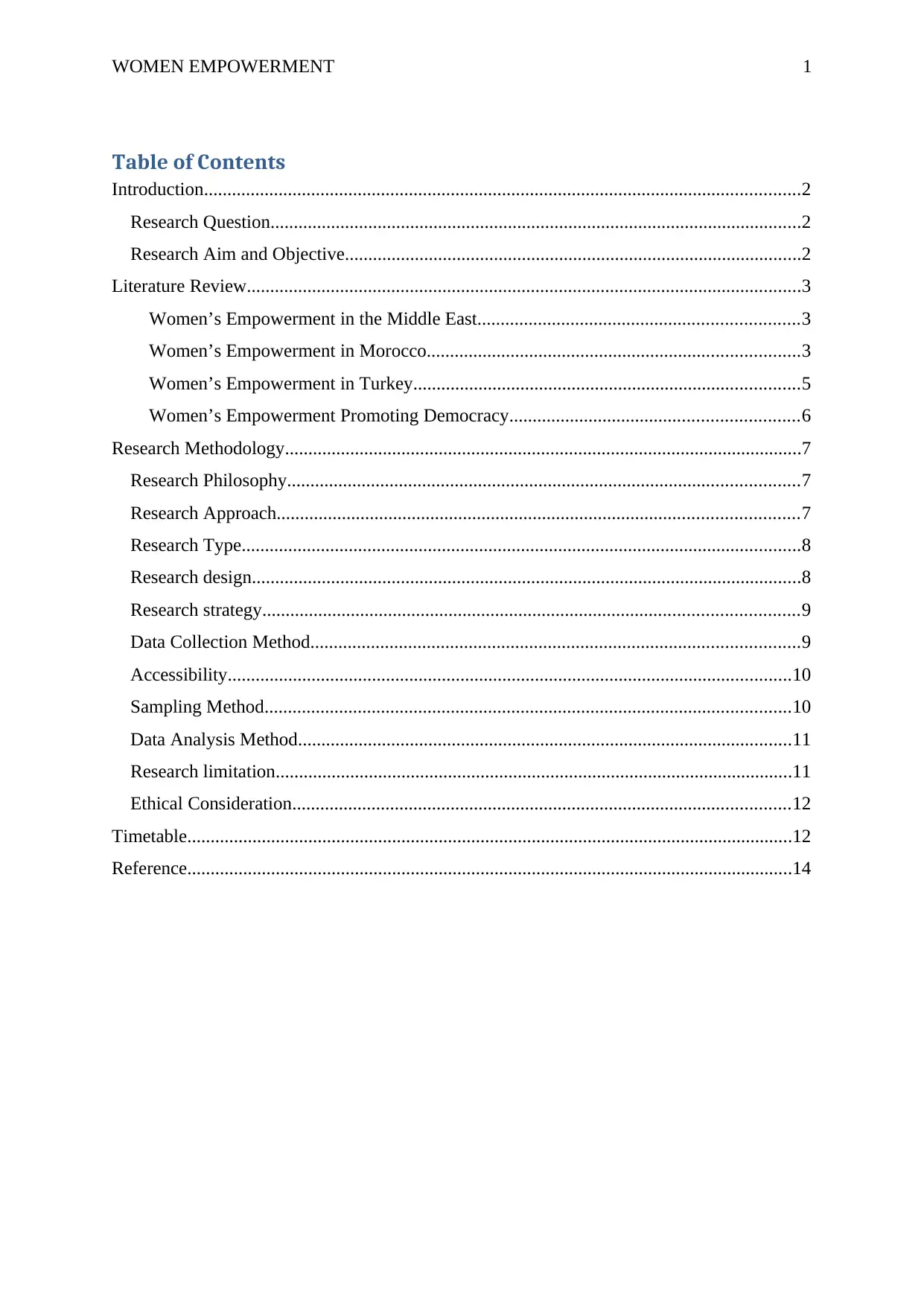
WOMEN EMPOWERMENT 1
Table of Contents
Introduction................................................................................................................................2
Research Question..................................................................................................................2
Research Aim and Objective..................................................................................................2
Literature Review.......................................................................................................................3
Women’s Empowerment in the Middle East.....................................................................3
Women’s Empowerment in Morocco................................................................................3
Women’s Empowerment in Turkey...................................................................................5
Women’s Empowerment Promoting Democracy..............................................................6
Research Methodology...............................................................................................................7
Research Philosophy..............................................................................................................7
Research Approach................................................................................................................7
Research Type........................................................................................................................8
Research design......................................................................................................................8
Research strategy...................................................................................................................9
Data Collection Method.........................................................................................................9
Accessibility.........................................................................................................................10
Sampling Method.................................................................................................................10
Data Analysis Method..........................................................................................................11
Research limitation...............................................................................................................11
Ethical Consideration...........................................................................................................12
Timetable..................................................................................................................................12
Reference..................................................................................................................................14
Table of Contents
Introduction................................................................................................................................2
Research Question..................................................................................................................2
Research Aim and Objective..................................................................................................2
Literature Review.......................................................................................................................3
Women’s Empowerment in the Middle East.....................................................................3
Women’s Empowerment in Morocco................................................................................3
Women’s Empowerment in Turkey...................................................................................5
Women’s Empowerment Promoting Democracy..............................................................6
Research Methodology...............................................................................................................7
Research Philosophy..............................................................................................................7
Research Approach................................................................................................................7
Research Type........................................................................................................................8
Research design......................................................................................................................8
Research strategy...................................................................................................................9
Data Collection Method.........................................................................................................9
Accessibility.........................................................................................................................10
Sampling Method.................................................................................................................10
Data Analysis Method..........................................................................................................11
Research limitation...............................................................................................................11
Ethical Consideration...........................................................................................................12
Timetable..................................................................................................................................12
Reference..................................................................................................................................14
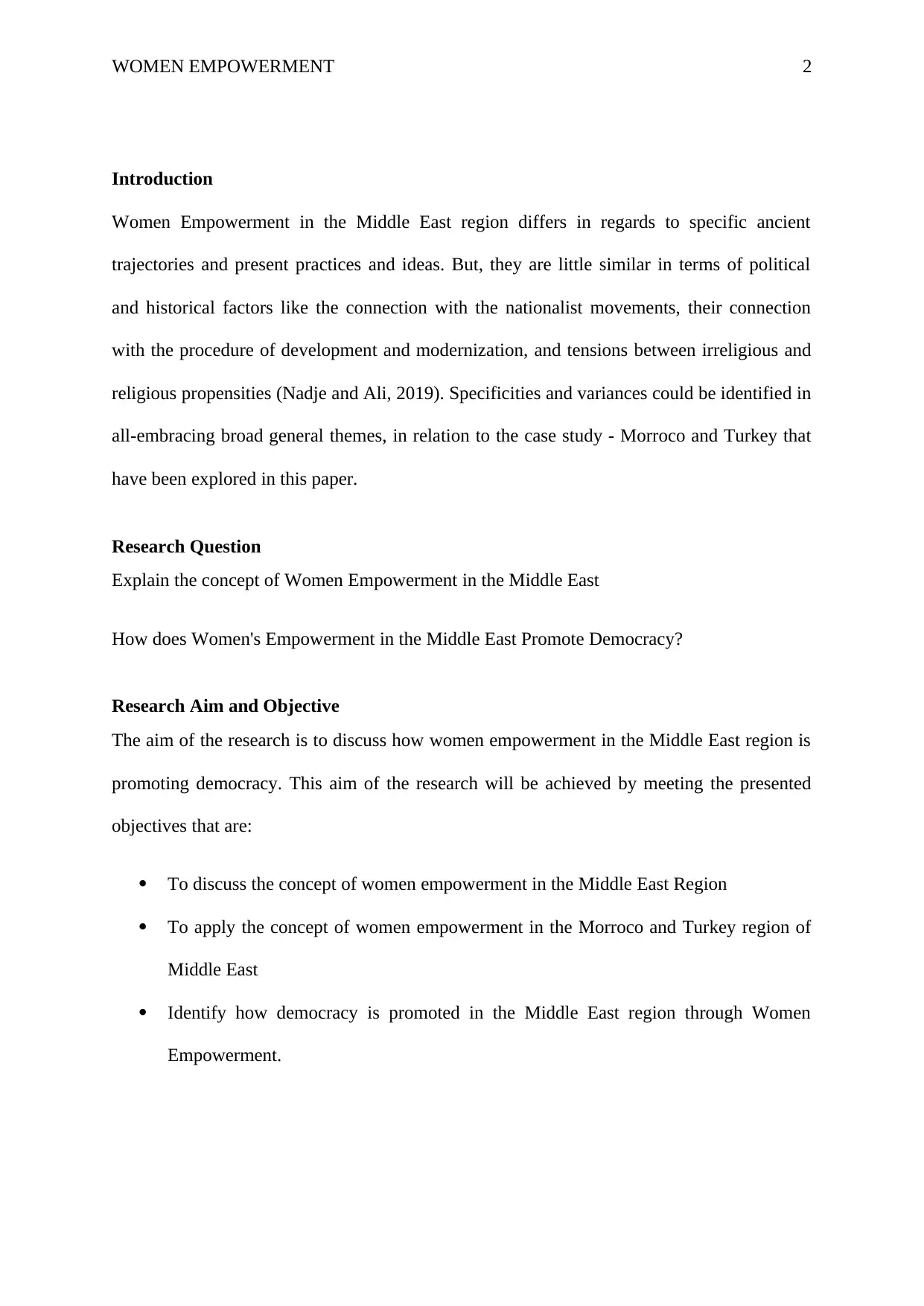
WOMEN EMPOWERMENT 2
Introduction
Women Empowerment in the Middle East region differs in regards to specific ancient
trajectories and present practices and ideas. But, they are little similar in terms of political
and historical factors like the connection with the nationalist movements, their connection
with the procedure of development and modernization, and tensions between irreligious and
religious propensities (Nadje and Ali, 2019). Specificities and variances could be identified in
all-embracing broad general themes, in relation to the case study - Morroco and Turkey that
have been explored in this paper.
Research Question
Explain the concept of Women Empowerment in the Middle East
How does Women's Empowerment in the Middle East Promote Democracy?
Research Aim and Objective
The aim of the research is to discuss how women empowerment in the Middle East region is
promoting democracy. This aim of the research will be achieved by meeting the presented
objectives that are:
To discuss the concept of women empowerment in the Middle East Region
To apply the concept of women empowerment in the Morroco and Turkey region of
Middle East
Identify how democracy is promoted in the Middle East region through Women
Empowerment.
Introduction
Women Empowerment in the Middle East region differs in regards to specific ancient
trajectories and present practices and ideas. But, they are little similar in terms of political
and historical factors like the connection with the nationalist movements, their connection
with the procedure of development and modernization, and tensions between irreligious and
religious propensities (Nadje and Ali, 2019). Specificities and variances could be identified in
all-embracing broad general themes, in relation to the case study - Morroco and Turkey that
have been explored in this paper.
Research Question
Explain the concept of Women Empowerment in the Middle East
How does Women's Empowerment in the Middle East Promote Democracy?
Research Aim and Objective
The aim of the research is to discuss how women empowerment in the Middle East region is
promoting democracy. This aim of the research will be achieved by meeting the presented
objectives that are:
To discuss the concept of women empowerment in the Middle East Region
To apply the concept of women empowerment in the Morroco and Turkey region of
Middle East
Identify how democracy is promoted in the Middle East region through Women
Empowerment.
⊘ This is a preview!⊘
Do you want full access?
Subscribe today to unlock all pages.

Trusted by 1+ million students worldwide

WOMEN EMPOWERMENT 3
Literature Review
According to Rahman (2013), Women’s empowerment is the procedure under which women
intricate and re-forms what they could do, can become, and attain in a situation that was
denied in the past. Empowerment could be determined in a number of ways, but in the
context of women's empowerment, it is about allowing and accepting women into the
procedure f decision making.
Women’s Empowerment in the Middle East
Gender equality is one of the critical issues to enhance the situation of the labor market of
young women and men in the region of the Middle East and North Africa. This is also called
as MENA region. This region is also considered as the highest youth unemployment at a
global level. For young women, this circumstance is severe, for instance in the year 2015,
around 27% of women were employed contrasted with around 77% of men (International
Labour office, 2019). According to International Labour Office (2019), in the year 2014, the
young women unemployment rate surpassed in comparison of young men in the region of
MENA by over 20% points. The young women who are skilled with higher education get less
job opportunity in comparison to their lower educated peers. This situation is specifically in
the Tunisia, Jordan, and Egypt area, whereas in the Gulf nations higher education is linked to
the more promising employment rate.
Women’s Empowerment in Morocco
Women in the Moroccan Society deal with a number of challenges. According to Kadi
(2016), the issues like gender inequality are one of the major concern due to which Morocco
is ranked on the 139th position in the list of 145 nations on the 2015 Global Gender Gap
Report issued by the World Economic Forum. The report also highlighted that the absence of
quality of education for girls is one of the huge barriers in the way of bridging the gender gap
in Morocco.
Literature Review
According to Rahman (2013), Women’s empowerment is the procedure under which women
intricate and re-forms what they could do, can become, and attain in a situation that was
denied in the past. Empowerment could be determined in a number of ways, but in the
context of women's empowerment, it is about allowing and accepting women into the
procedure f decision making.
Women’s Empowerment in the Middle East
Gender equality is one of the critical issues to enhance the situation of the labor market of
young women and men in the region of the Middle East and North Africa. This is also called
as MENA region. This region is also considered as the highest youth unemployment at a
global level. For young women, this circumstance is severe, for instance in the year 2015,
around 27% of women were employed contrasted with around 77% of men (International
Labour office, 2019). According to International Labour Office (2019), in the year 2014, the
young women unemployment rate surpassed in comparison of young men in the region of
MENA by over 20% points. The young women who are skilled with higher education get less
job opportunity in comparison to their lower educated peers. This situation is specifically in
the Tunisia, Jordan, and Egypt area, whereas in the Gulf nations higher education is linked to
the more promising employment rate.
Women’s Empowerment in Morocco
Women in the Moroccan Society deal with a number of challenges. According to Kadi
(2016), the issues like gender inequality are one of the major concern due to which Morocco
is ranked on the 139th position in the list of 145 nations on the 2015 Global Gender Gap
Report issued by the World Economic Forum. The report also highlighted that the absence of
quality of education for girls is one of the huge barriers in the way of bridging the gender gap
in Morocco.
Paraphrase This Document
Need a fresh take? Get an instant paraphrase of this document with our AI Paraphraser
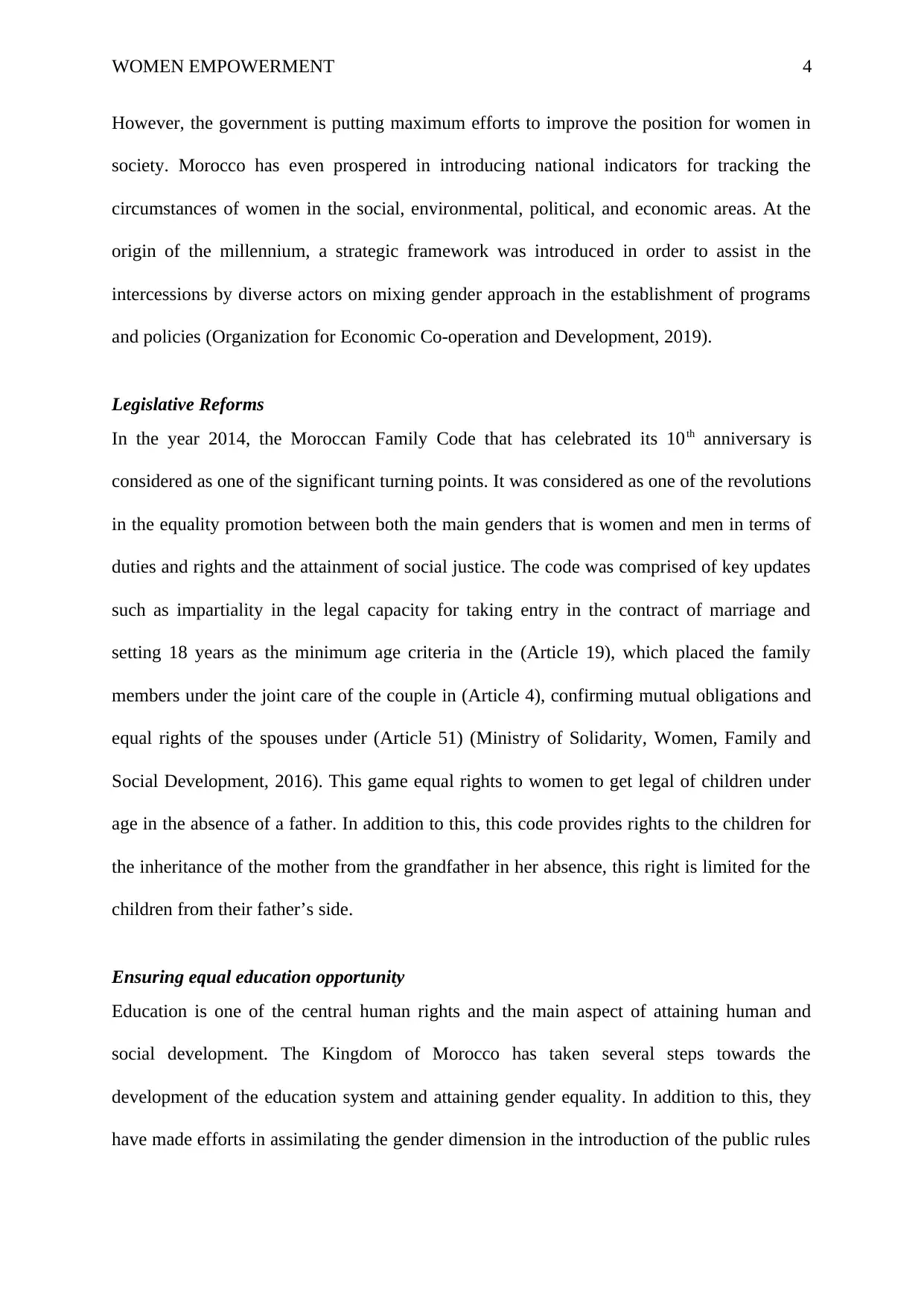
WOMEN EMPOWERMENT 4
However, the government is putting maximum efforts to improve the position for women in
society. Morocco has even prospered in introducing national indicators for tracking the
circumstances of women in the social, environmental, political, and economic areas. At the
origin of the millennium, a strategic framework was introduced in order to assist in the
intercessions by diverse actors on mixing gender approach in the establishment of programs
and policies (Organization for Economic Co-operation and Development, 2019).
Legislative Reforms
In the year 2014, the Moroccan Family Code that has celebrated its 10th anniversary is
considered as one of the significant turning points. It was considered as one of the revolutions
in the equality promotion between both the main genders that is women and men in terms of
duties and rights and the attainment of social justice. The code was comprised of key updates
such as impartiality in the legal capacity for taking entry in the contract of marriage and
setting 18 years as the minimum age criteria in the (Article 19), which placed the family
members under the joint care of the couple in (Article 4), confirming mutual obligations and
equal rights of the spouses under (Article 51) (Ministry of Solidarity, Women, Family and
Social Development, 2016). This game equal rights to women to get legal of children under
age in the absence of a father. In addition to this, this code provides rights to the children for
the inheritance of the mother from the grandfather in her absence, this right is limited for the
children from their father’s side.
Ensuring equal education opportunity
Education is one of the central human rights and the main aspect of attaining human and
social development. The Kingdom of Morocco has taken several steps towards the
development of the education system and attaining gender equality. In addition to this, they
have made efforts in assimilating the gender dimension in the introduction of the public rules
However, the government is putting maximum efforts to improve the position for women in
society. Morocco has even prospered in introducing national indicators for tracking the
circumstances of women in the social, environmental, political, and economic areas. At the
origin of the millennium, a strategic framework was introduced in order to assist in the
intercessions by diverse actors on mixing gender approach in the establishment of programs
and policies (Organization for Economic Co-operation and Development, 2019).
Legislative Reforms
In the year 2014, the Moroccan Family Code that has celebrated its 10th anniversary is
considered as one of the significant turning points. It was considered as one of the revolutions
in the equality promotion between both the main genders that is women and men in terms of
duties and rights and the attainment of social justice. The code was comprised of key updates
such as impartiality in the legal capacity for taking entry in the contract of marriage and
setting 18 years as the minimum age criteria in the (Article 19), which placed the family
members under the joint care of the couple in (Article 4), confirming mutual obligations and
equal rights of the spouses under (Article 51) (Ministry of Solidarity, Women, Family and
Social Development, 2016). This game equal rights to women to get legal of children under
age in the absence of a father. In addition to this, this code provides rights to the children for
the inheritance of the mother from the grandfather in her absence, this right is limited for the
children from their father’s side.
Ensuring equal education opportunity
Education is one of the central human rights and the main aspect of attaining human and
social development. The Kingdom of Morocco has taken several steps towards the
development of the education system and attaining gender equality. In addition to this, they
have made efforts in assimilating the gender dimension in the introduction of the public rules
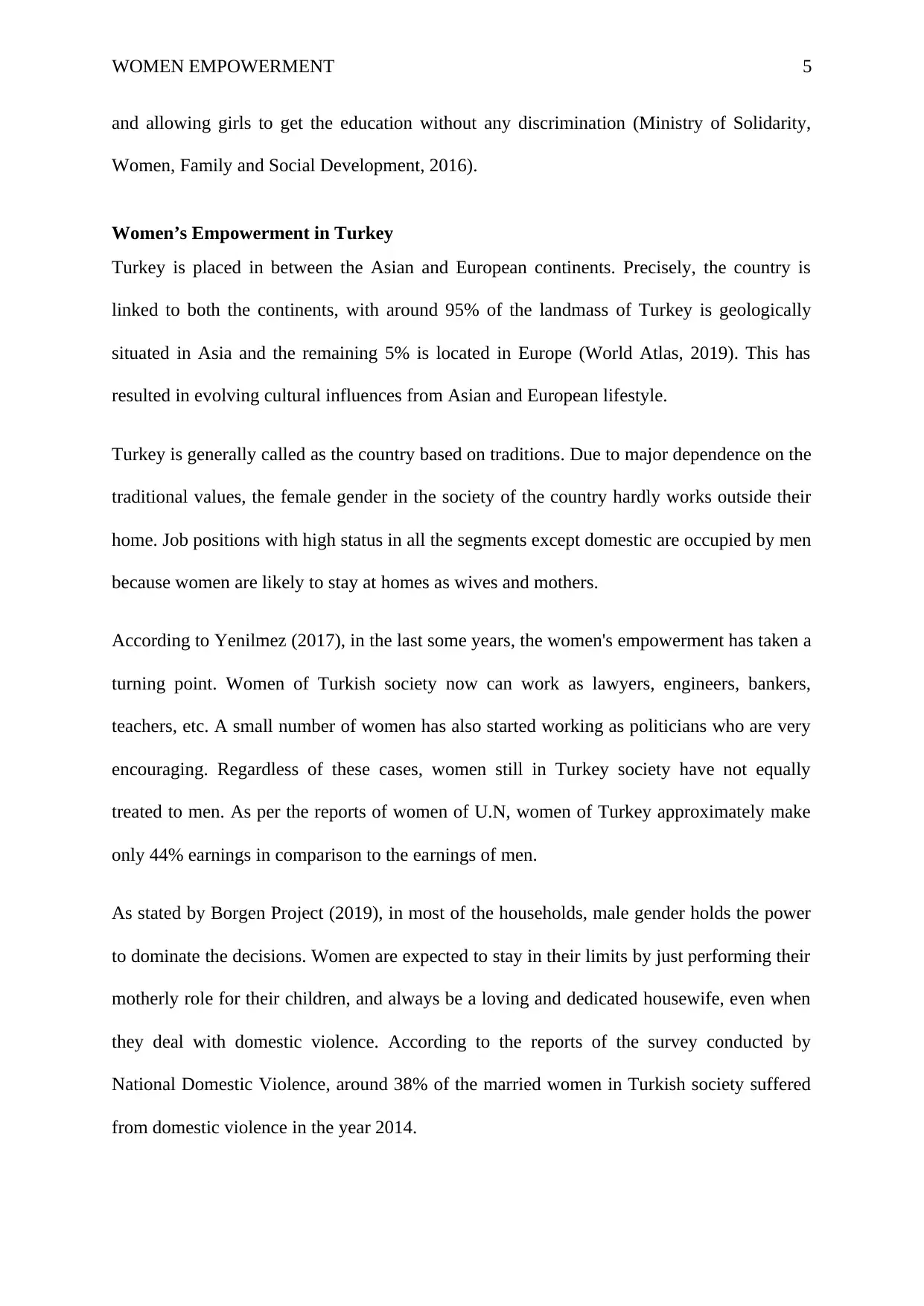
WOMEN EMPOWERMENT 5
and allowing girls to get the education without any discrimination (Ministry of Solidarity,
Women, Family and Social Development, 2016).
Women’s Empowerment in Turkey
Turkey is placed in between the Asian and European continents. Precisely, the country is
linked to both the continents, with around 95% of the landmass of Turkey is geologically
situated in Asia and the remaining 5% is located in Europe (World Atlas, 2019). This has
resulted in evolving cultural influences from Asian and European lifestyle.
Turkey is generally called as the country based on traditions. Due to major dependence on the
traditional values, the female gender in the society of the country hardly works outside their
home. Job positions with high status in all the segments except domestic are occupied by men
because women are likely to stay at homes as wives and mothers.
According to Yenilmez (2017), in the last some years, the women's empowerment has taken a
turning point. Women of Turkish society now can work as lawyers, engineers, bankers,
teachers, etc. A small number of women has also started working as politicians who are very
encouraging. Regardless of these cases, women still in Turkey society have not equally
treated to men. As per the reports of women of U.N, women of Turkey approximately make
only 44% earnings in comparison to the earnings of men.
As stated by Borgen Project (2019), in most of the households, male gender holds the power
to dominate the decisions. Women are expected to stay in their limits by just performing their
motherly role for their children, and always be a loving and dedicated housewife, even when
they deal with domestic violence. According to the reports of the survey conducted by
National Domestic Violence, around 38% of the married women in Turkish society suffered
from domestic violence in the year 2014.
and allowing girls to get the education without any discrimination (Ministry of Solidarity,
Women, Family and Social Development, 2016).
Women’s Empowerment in Turkey
Turkey is placed in between the Asian and European continents. Precisely, the country is
linked to both the continents, with around 95% of the landmass of Turkey is geologically
situated in Asia and the remaining 5% is located in Europe (World Atlas, 2019). This has
resulted in evolving cultural influences from Asian and European lifestyle.
Turkey is generally called as the country based on traditions. Due to major dependence on the
traditional values, the female gender in the society of the country hardly works outside their
home. Job positions with high status in all the segments except domestic are occupied by men
because women are likely to stay at homes as wives and mothers.
According to Yenilmez (2017), in the last some years, the women's empowerment has taken a
turning point. Women of Turkish society now can work as lawyers, engineers, bankers,
teachers, etc. A small number of women has also started working as politicians who are very
encouraging. Regardless of these cases, women still in Turkey society have not equally
treated to men. As per the reports of women of U.N, women of Turkey approximately make
only 44% earnings in comparison to the earnings of men.
As stated by Borgen Project (2019), in most of the households, male gender holds the power
to dominate the decisions. Women are expected to stay in their limits by just performing their
motherly role for their children, and always be a loving and dedicated housewife, even when
they deal with domestic violence. According to the reports of the survey conducted by
National Domestic Violence, around 38% of the married women in Turkish society suffered
from domestic violence in the year 2014.
⊘ This is a preview!⊘
Do you want full access?
Subscribe today to unlock all pages.

Trusted by 1+ million students worldwide

WOMEN EMPOWERMENT 6
As discussed above, the perception towards women is changing slowly with time in Turkey
society. During the 2000s, the government of Turkey has framed different legislation for
protecting the rights of women and safeguarding them from domestic violence and destroying
discrimination based on gender. But, the establishment of such laws has yet not successfully
implemented in the country.
According to Yenilmez and Izmir (2019), gender inequality is still the major issue of the
Turkish society, but women’s empowerment in the country has taken rise and growth in last
some years. In addition to this, the government of the UN introduced different campaign
which was majorly focused on improving the women’s lives in Turkey. Initiatives taken by
the government like the three-year program is working to change the mindset of men in the
society and fighting against the violence as well as discrimination in the basis of gender,
which highlights the attention towards women who are part of most disadvantaged groups.
Women’s Empowerment Promoting Democracy
The women’s empowerment and introduction of gender equality reforms are some of the
crucial steps to democracy. Democracy is more about the rights of citizens, contribution and
presence in comparison to the elections, political parties, balances, and checks. The
democracy quality is defined not just by the institutions' form, but it is about the participation
of diverse social groups in these institutions. In this context, the gender of democracy highly
matters. The lack of women participation in political life leads to "male democracy", which is
also considered as a biased democracy or incomplete democracy (Moghadam, 2008).
In US and European countries like Britain, democratic rights were firstly provided to the
white males, which are also extended to women and then to the rest of the male population.
In other regions of the world, women's rights expansion is moving hand in hand with the
development of democracy in the country. In these countries, women are performing a major
As discussed above, the perception towards women is changing slowly with time in Turkey
society. During the 2000s, the government of Turkey has framed different legislation for
protecting the rights of women and safeguarding them from domestic violence and destroying
discrimination based on gender. But, the establishment of such laws has yet not successfully
implemented in the country.
According to Yenilmez and Izmir (2019), gender inequality is still the major issue of the
Turkish society, but women’s empowerment in the country has taken rise and growth in last
some years. In addition to this, the government of the UN introduced different campaign
which was majorly focused on improving the women’s lives in Turkey. Initiatives taken by
the government like the three-year program is working to change the mindset of men in the
society and fighting against the violence as well as discrimination in the basis of gender,
which highlights the attention towards women who are part of most disadvantaged groups.
Women’s Empowerment Promoting Democracy
The women’s empowerment and introduction of gender equality reforms are some of the
crucial steps to democracy. Democracy is more about the rights of citizens, contribution and
presence in comparison to the elections, political parties, balances, and checks. The
democracy quality is defined not just by the institutions' form, but it is about the participation
of diverse social groups in these institutions. In this context, the gender of democracy highly
matters. The lack of women participation in political life leads to "male democracy", which is
also considered as a biased democracy or incomplete democracy (Moghadam, 2008).
In US and European countries like Britain, democratic rights were firstly provided to the
white males, which are also extended to women and then to the rest of the male population.
In other regions of the world, women's rights expansion is moving hand in hand with the
development of democracy in the country. In these countries, women are performing a major
Paraphrase This Document
Need a fresh take? Get an instant paraphrase of this document with our AI Paraphraser
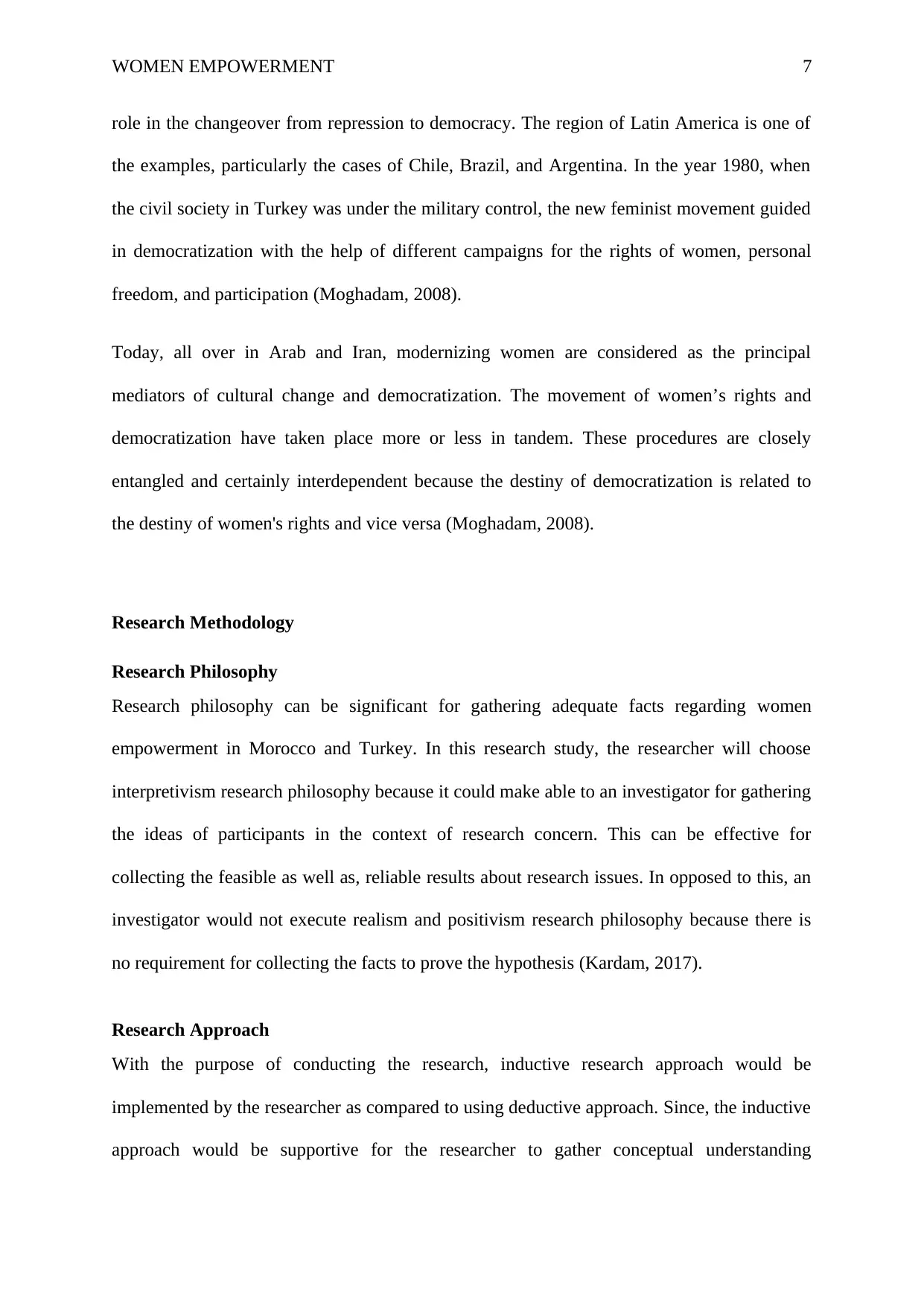
WOMEN EMPOWERMENT 7
role in the changeover from repression to democracy. The region of Latin America is one of
the examples, particularly the cases of Chile, Brazil, and Argentina. In the year 1980, when
the civil society in Turkey was under the military control, the new feminist movement guided
in democratization with the help of different campaigns for the rights of women, personal
freedom, and participation (Moghadam, 2008).
Today, all over in Arab and Iran, modernizing women are considered as the principal
mediators of cultural change and democratization. The movement of women’s rights and
democratization have taken place more or less in tandem. These procedures are closely
entangled and certainly interdependent because the destiny of democratization is related to
the destiny of women's rights and vice versa (Moghadam, 2008).
Research Methodology
Research Philosophy
Research philosophy can be significant for gathering adequate facts regarding women
empowerment in Morocco and Turkey. In this research study, the researcher will choose
interpretivism research philosophy because it could make able to an investigator for gathering
the ideas of participants in the context of research concern. This can be effective for
collecting the feasible as well as, reliable results about research issues. In opposed to this, an
investigator would not execute realism and positivism research philosophy because there is
no requirement for collecting the facts to prove the hypothesis (Kardam, 2017).
Research Approach
With the purpose of conducting the research, inductive research approach would be
implemented by the researcher as compared to using deductive approach. Since, the inductive
approach would be supportive for the researcher to gather conceptual understanding
role in the changeover from repression to democracy. The region of Latin America is one of
the examples, particularly the cases of Chile, Brazil, and Argentina. In the year 1980, when
the civil society in Turkey was under the military control, the new feminist movement guided
in democratization with the help of different campaigns for the rights of women, personal
freedom, and participation (Moghadam, 2008).
Today, all over in Arab and Iran, modernizing women are considered as the principal
mediators of cultural change and democratization. The movement of women’s rights and
democratization have taken place more or less in tandem. These procedures are closely
entangled and certainly interdependent because the destiny of democratization is related to
the destiny of women's rights and vice versa (Moghadam, 2008).
Research Methodology
Research Philosophy
Research philosophy can be significant for gathering adequate facts regarding women
empowerment in Morocco and Turkey. In this research study, the researcher will choose
interpretivism research philosophy because it could make able to an investigator for gathering
the ideas of participants in the context of research concern. This can be effective for
collecting the feasible as well as, reliable results about research issues. In opposed to this, an
investigator would not execute realism and positivism research philosophy because there is
no requirement for collecting the facts to prove the hypothesis (Kardam, 2017).
Research Approach
With the purpose of conducting the research, inductive research approach would be
implemented by the researcher as compared to using deductive approach. Since, the inductive
approach would be supportive for the researcher to gather conceptual understanding

WOMEN EMPOWERMENT 8
regarding the women empowerment in Morocco and Turkey. It would be supportive for the
researcher to gain the strength as well as, stability about research results. A researcher will be
beneficial to reach a particular conclusion as well as, discusses the women empowerment in
Morroco and Turkey (Omar, Fadzil, & Hamidi, 2017).
In contrast to this, the deductive research approach will not be implemented by a researcher
because it cannot be appropriate for gathering significant information about research concern.
It will also not be applied through an investigator because there is no requirement for
developing the hypothesis. Consequently, this approach cannot be effective in capturing the
relevant facts and figures regarding research issues (Akhami, Ertürk, and Mayer, 2018).
Research Type
In the context of this investigation, a researcher would execute explanatory research for
determining the research concerns in depth. This research design can facilitate a researcher in
terms of gathering reliable information about investigation issue. A researcher can be able to
gather the observation about respondents in the context of the research issue. It will be
beneficial for completing the aim and objectives in specified time duration (Rizzo, 2017).
It is also significant for comprehending the cause and effect association among women
empowerment and democracy. In contrast to this, a researcher will not practice exploratory
research design as there is no requirement for gathering the new information (Sarica, et. al.,
2018).
Research design
Research design is used for accomplishing the aim as well as, objectives of investigation in a
systematic manner. There is some kind of research strategy that could be applied by
researcher such as qualitative, quantitative and mixed research design. In this research, a
researcher will execute a mixed research design for creating feasible results and resolves the
investigation issues. In such a manner, a quantitative research strategy would make
regarding the women empowerment in Morocco and Turkey. It would be supportive for the
researcher to gain the strength as well as, stability about research results. A researcher will be
beneficial to reach a particular conclusion as well as, discusses the women empowerment in
Morroco and Turkey (Omar, Fadzil, & Hamidi, 2017).
In contrast to this, the deductive research approach will not be implemented by a researcher
because it cannot be appropriate for gathering significant information about research concern.
It will also not be applied through an investigator because there is no requirement for
developing the hypothesis. Consequently, this approach cannot be effective in capturing the
relevant facts and figures regarding research issues (Akhami, Ertürk, and Mayer, 2018).
Research Type
In the context of this investigation, a researcher would execute explanatory research for
determining the research concerns in depth. This research design can facilitate a researcher in
terms of gathering reliable information about investigation issue. A researcher can be able to
gather the observation about respondents in the context of the research issue. It will be
beneficial for completing the aim and objectives in specified time duration (Rizzo, 2017).
It is also significant for comprehending the cause and effect association among women
empowerment and democracy. In contrast to this, a researcher will not practice exploratory
research design as there is no requirement for gathering the new information (Sarica, et. al.,
2018).
Research design
Research design is used for accomplishing the aim as well as, objectives of investigation in a
systematic manner. There is some kind of research strategy that could be applied by
researcher such as qualitative, quantitative and mixed research design. In this research, a
researcher will execute a mixed research design for creating feasible results and resolves the
investigation issues. In such a manner, a quantitative research strategy would make
⊘ This is a preview!⊘
Do you want full access?
Subscribe today to unlock all pages.

Trusted by 1+ million students worldwide
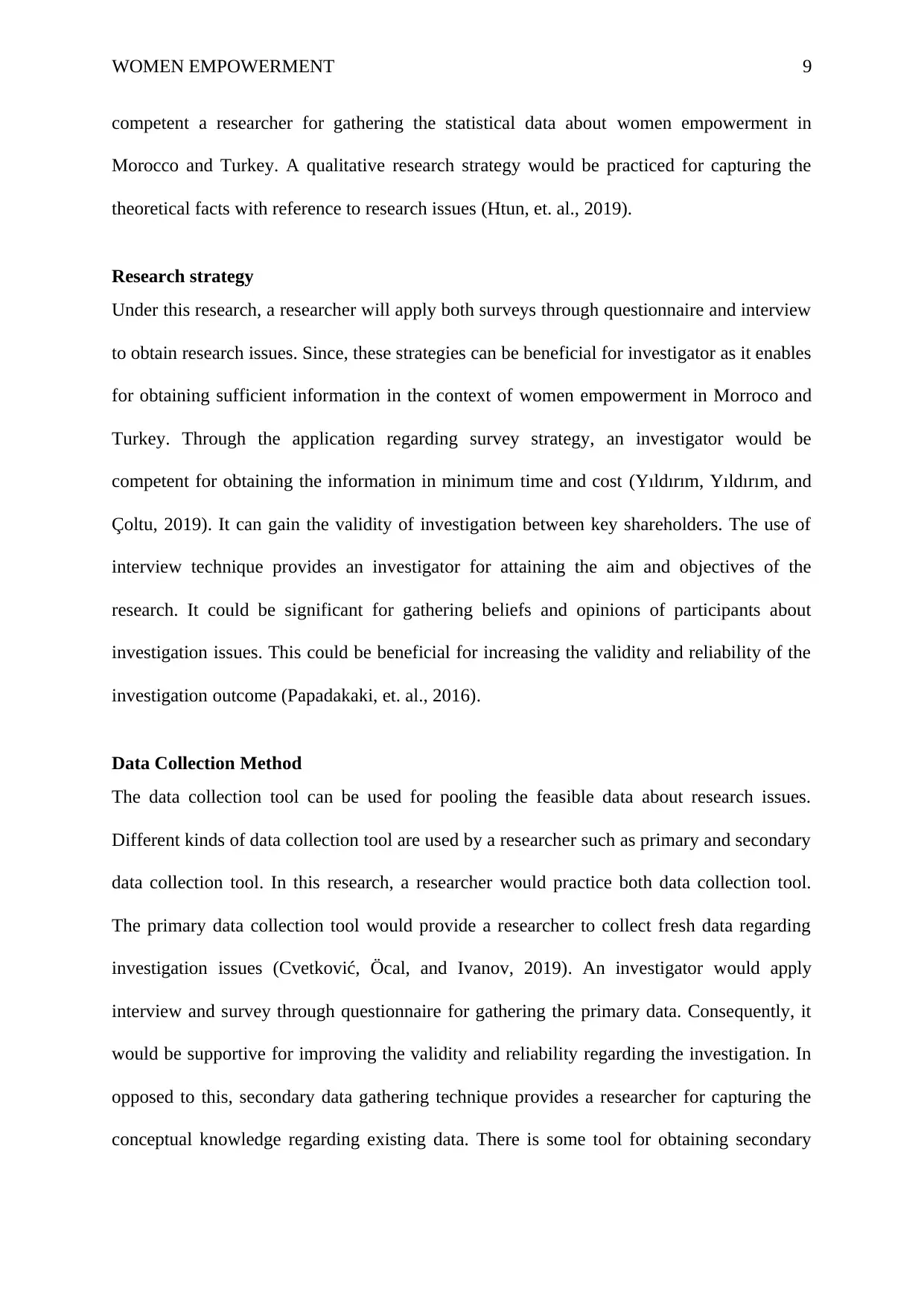
WOMEN EMPOWERMENT 9
competent a researcher for gathering the statistical data about women empowerment in
Morocco and Turkey. A qualitative research strategy would be practiced for capturing the
theoretical facts with reference to research issues (Htun, et. al., 2019).
Research strategy
Under this research, a researcher will apply both surveys through questionnaire and interview
to obtain research issues. Since, these strategies can be beneficial for investigator as it enables
for obtaining sufficient information in the context of women empowerment in Morroco and
Turkey. Through the application regarding survey strategy, an investigator would be
competent for obtaining the information in minimum time and cost (Yıldırım, Yıldırım, and
Çoltu, 2019). It can gain the validity of investigation between key shareholders. The use of
interview technique provides an investigator for attaining the aim and objectives of the
research. It could be significant for gathering beliefs and opinions of participants about
investigation issues. This could be beneficial for increasing the validity and reliability of the
investigation outcome (Papadakaki, et. al., 2016).
Data Collection Method
The data collection tool can be used for pooling the feasible data about research issues.
Different kinds of data collection tool are used by a researcher such as primary and secondary
data collection tool. In this research, a researcher would practice both data collection tool.
The primary data collection tool would provide a researcher to collect fresh data regarding
investigation issues (Cvetković, Öcal, and Ivanov, 2019). An investigator would apply
interview and survey through questionnaire for gathering the primary data. Consequently, it
would be supportive for improving the validity and reliability regarding the investigation. In
opposed to this, secondary data gathering technique provides a researcher for capturing the
conceptual knowledge regarding existing data. There is some tool for obtaining secondary
competent a researcher for gathering the statistical data about women empowerment in
Morocco and Turkey. A qualitative research strategy would be practiced for capturing the
theoretical facts with reference to research issues (Htun, et. al., 2019).
Research strategy
Under this research, a researcher will apply both surveys through questionnaire and interview
to obtain research issues. Since, these strategies can be beneficial for investigator as it enables
for obtaining sufficient information in the context of women empowerment in Morroco and
Turkey. Through the application regarding survey strategy, an investigator would be
competent for obtaining the information in minimum time and cost (Yıldırım, Yıldırım, and
Çoltu, 2019). It can gain the validity of investigation between key shareholders. The use of
interview technique provides an investigator for attaining the aim and objectives of the
research. It could be significant for gathering beliefs and opinions of participants about
investigation issues. This could be beneficial for increasing the validity and reliability of the
investigation outcome (Papadakaki, et. al., 2016).
Data Collection Method
The data collection tool can be used for pooling the feasible data about research issues.
Different kinds of data collection tool are used by a researcher such as primary and secondary
data collection tool. In this research, a researcher would practice both data collection tool.
The primary data collection tool would provide a researcher to collect fresh data regarding
investigation issues (Cvetković, Öcal, and Ivanov, 2019). An investigator would apply
interview and survey through questionnaire for gathering the primary data. Consequently, it
would be supportive for improving the validity and reliability regarding the investigation. In
opposed to this, secondary data gathering technique provides a researcher for capturing the
conceptual knowledge regarding existing data. There is some tool for obtaining secondary
Paraphrase This Document
Need a fresh take? Get an instant paraphrase of this document with our AI Paraphraser
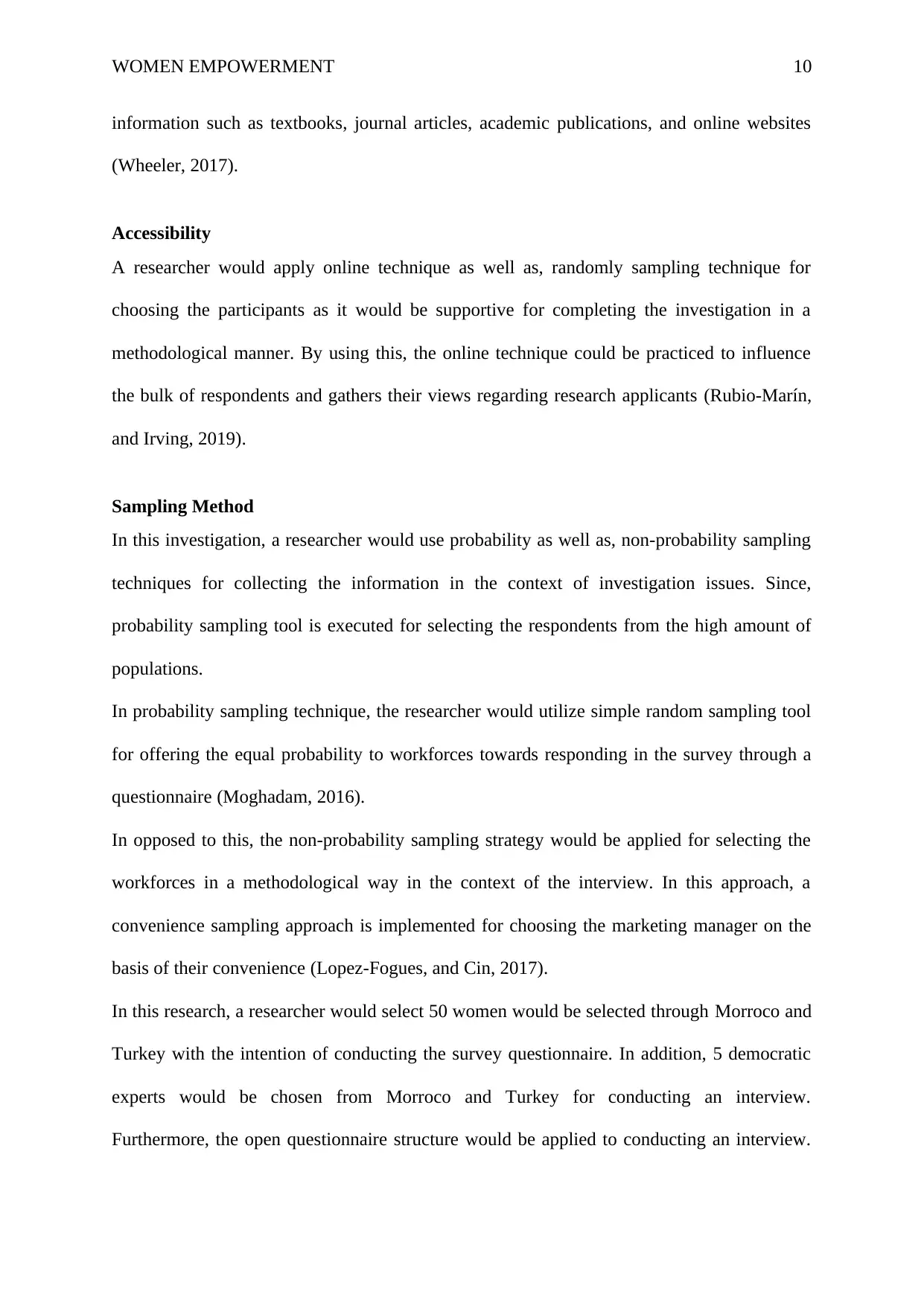
WOMEN EMPOWERMENT 10
information such as textbooks, journal articles, academic publications, and online websites
(Wheeler, 2017).
Accessibility
A researcher would apply online technique as well as, randomly sampling technique for
choosing the participants as it would be supportive for completing the investigation in a
methodological manner. By using this, the online technique could be practiced to influence
the bulk of respondents and gathers their views regarding research applicants (Rubio-Marín,
and Irving, 2019).
Sampling Method
In this investigation, a researcher would use probability as well as, non-probability sampling
techniques for collecting the information in the context of investigation issues. Since,
probability sampling tool is executed for selecting the respondents from the high amount of
populations.
In probability sampling technique, the researcher would utilize simple random sampling tool
for offering the equal probability to workforces towards responding in the survey through a
questionnaire (Moghadam, 2016).
In opposed to this, the non-probability sampling strategy would be applied for selecting the
workforces in a methodological way in the context of the interview. In this approach, a
convenience sampling approach is implemented for choosing the marketing manager on the
basis of their convenience (Lopez-Fogues, and Cin, 2017).
In this research, a researcher would select 50 women would be selected through Morroco and
Turkey with the intention of conducting the survey questionnaire. In addition, 5 democratic
experts would be chosen from Morroco and Turkey for conducting an interview.
Furthermore, the open questionnaire structure would be applied to conducting an interview.
information such as textbooks, journal articles, academic publications, and online websites
(Wheeler, 2017).
Accessibility
A researcher would apply online technique as well as, randomly sampling technique for
choosing the participants as it would be supportive for completing the investigation in a
methodological manner. By using this, the online technique could be practiced to influence
the bulk of respondents and gathers their views regarding research applicants (Rubio-Marín,
and Irving, 2019).
Sampling Method
In this investigation, a researcher would use probability as well as, non-probability sampling
techniques for collecting the information in the context of investigation issues. Since,
probability sampling tool is executed for selecting the respondents from the high amount of
populations.
In probability sampling technique, the researcher would utilize simple random sampling tool
for offering the equal probability to workforces towards responding in the survey through a
questionnaire (Moghadam, 2016).
In opposed to this, the non-probability sampling strategy would be applied for selecting the
workforces in a methodological way in the context of the interview. In this approach, a
convenience sampling approach is implemented for choosing the marketing manager on the
basis of their convenience (Lopez-Fogues, and Cin, 2017).
In this research, a researcher would select 50 women would be selected through Morroco and
Turkey with the intention of conducting the survey questionnaire. In addition, 5 democratic
experts would be chosen from Morroco and Turkey for conducting an interview.
Furthermore, the open questionnaire structure would be applied to conducting an interview.

WOMEN EMPOWERMENT 11
Along with this, a close-ended questionnaire would be practiced for responding to the survey
through a questionnaire.
Earlier implementation regarding the investigation, a researcher would send earlier approval
e-mail to democratic experts and women to get their approval. Under this mail, the researcher
would provide guidelines to a participant for giving a response in a survey (Moghadam,
2016).
Data Analysis Method
A data analysis tool is an essential tool for assessing the collected data regarding the
investigation. There are two tools for assessing information about research issues such as
statistical and inferential analysis techniques. In this research, a researcher would execute the
descriptive statistical data analysis tool for assessing the information in a methodological
manner. To obtain statistical data, a researcher would practice MS-excel software for
demonstrating valid and reliable results (Wheeler, 2017). A researcher would demonstrate the
information via several pie charts and bar charts, and column diagram. Consequently, it will
be significant for interpreting the information as well as, comprehending investigation
concerns in an easy way (Yıldırım, Yıldırım, and Çoltu, 2019).
Research limitation
Research limitation can directly affect the research result. Moreover, a researcher would
focus on some factor that can affect the feasibility of investigation. In order to conduct this
research, there could be chances for creating some limitation like inadequate resources, less
time as well as, less cost (Rizzo, 2017).
In such a manner, predetermined time would be used for completing the investigation in a
significant way. The primary data collection tool can take maximum time as it may affect the
research outcome. In order to eliminate the research issues, a researcher would practice e-
Along with this, a close-ended questionnaire would be practiced for responding to the survey
through a questionnaire.
Earlier implementation regarding the investigation, a researcher would send earlier approval
e-mail to democratic experts and women to get their approval. Under this mail, the researcher
would provide guidelines to a participant for giving a response in a survey (Moghadam,
2016).
Data Analysis Method
A data analysis tool is an essential tool for assessing the collected data regarding the
investigation. There are two tools for assessing information about research issues such as
statistical and inferential analysis techniques. In this research, a researcher would execute the
descriptive statistical data analysis tool for assessing the information in a methodological
manner. To obtain statistical data, a researcher would practice MS-excel software for
demonstrating valid and reliable results (Wheeler, 2017). A researcher would demonstrate the
information via several pie charts and bar charts, and column diagram. Consequently, it will
be significant for interpreting the information as well as, comprehending investigation
concerns in an easy way (Yıldırım, Yıldırım, and Çoltu, 2019).
Research limitation
Research limitation can directly affect the research result. Moreover, a researcher would
focus on some factor that can affect the feasibility of investigation. In order to conduct this
research, there could be chances for creating some limitation like inadequate resources, less
time as well as, less cost (Rizzo, 2017).
In such a manner, predetermined time would be used for completing the investigation in a
significant way. The primary data collection tool can take maximum time as it may affect the
research outcome. In order to eliminate the research issues, a researcher would practice e-
⊘ This is a preview!⊘
Do you want full access?
Subscribe today to unlock all pages.

Trusted by 1+ million students worldwide
1 out of 17
Related Documents
Your All-in-One AI-Powered Toolkit for Academic Success.
+13062052269
info@desklib.com
Available 24*7 on WhatsApp / Email
![[object Object]](/_next/static/media/star-bottom.7253800d.svg)
Unlock your academic potential
Copyright © 2020–2025 A2Z Services. All Rights Reserved. Developed and managed by ZUCOL.



